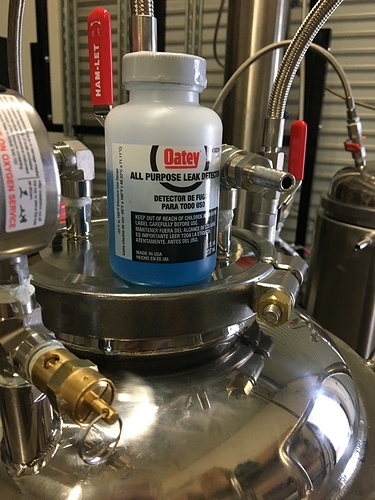Setting a new system up. What’s the best way to chase down a leak you can’t find? I have the blue liquid leak detector from the hardware store. Usually works great. But can’t find this leak this time
Pressurize it to 100psi and stick it in the bath tub. Pretty easy to see it unless your only losing like a 1/4psi over 24hrs. then i take it up to 150 and it usually exposes itself.
Check your valves.
Water bath if you can, otherwise isolate as much as you can to divide your search area. Do this by valving off any sections of your system that you can isolate. It can cut out half or more of the connections you need to check. Also check valve assemblies they can leak through the stem if worn or not assembled correctly. When I troubleshoot any complex system I always try to eliminate my search “area” by half each time I test.
Also a good idea to check any “tested” parts or assemblies. Sometimes the parts tested after the shop dab session are iffy. Had my share of fun crap sent that was tested but didn’t pass my tests
It’s a monster (8x48)
Tub won’t do. The valves are all brand new ham let valves.
I know it’s not the lid on the pot or the solvent tank or the sieve as I did those separate. I put it to 120 last night. At 115. Just tightened all the clamps. Think one was a little loose maybe.
Usually this leak detector is fantastic. Which is why I’m leaning toward a clamp. Will let you know
Ive experienced some steel braided hoses being faulty as well if you are using those.
So I hate to be the dumb redneck here…but a pressurized leak will show up with soapy water. Now I wouldn’t go spraying my entire extractor down with it, but if I suspected a specific joint…and it wasnt easily dunkable in a tub…a quick squirt would telll me if its leaking.
Worked in finding leaky bmx inner tubes back in the day. Also great when installing new gas lines in your house.
That’s how I did my downhill tubes back in the day, the propane lines in my house, and how the my employer checks ventilation valves as well as other low air pressure components. Can’t really argue with the results…
I’m using this fancy city soup and water mix from Home Depot. It’s made for this purpose
spray down the whole system one joint at a time.
the hamlet valves are suspect. anything with tape is suspect. make sure your gaskets are also seated correctly. (if they are ptfe just throw them out and buy something flexible.)
*edit: looking at the tape job on that gauge you should grab some master’s orange. two wraps only. skip the initial thread. it’s thicker and leaks less.
Food coloring in the h20 soapy spray bottle helps seeing the color/bubbles easier.
What your seeing is excess venom pipe dope. Works amazing. I also use the venom tape. Super thick. It’s usually perfect the first time with no leaks. It’s sitting pretty at 115 so I’m thinking it was a loose clamp
Check your welds if that’s not a certified system.
I got a swimming pool in my backyard. Any extractor fits. ![]()
And 5psi over night is a pretty big leak. It should be very noticeable. This is a running leak from my experience
absolute safest and best way is to hydrostatic test them.
grab one of these: https://www.amazon.com/RP50-Hydrostatic-Pressure-Test-Pump/dp/B00KXUD0KY/
bottom flood your cls with water (get all the air out) and then use the rp50 to pump the whole cls up to 100psi (or 200++psi go nuts - just dont break your sights.)
it will just gently weep water out of any leak points.
Why are you using pipe dope AND thread tape?
Because that’s what it says to do. Also that’s how the folks at hfs assemble all their gear from their warehouse. I haven’t had an issue until now and have been using it for a while. It’s usually perfect with zero leaks the first time

